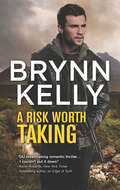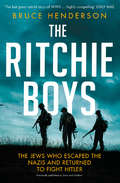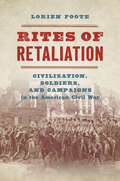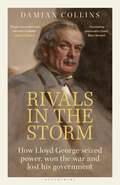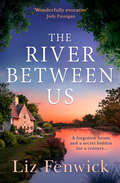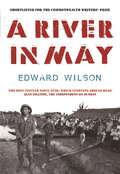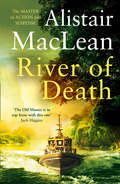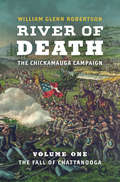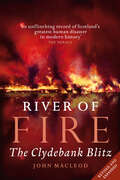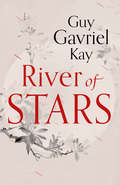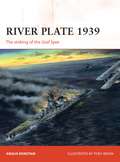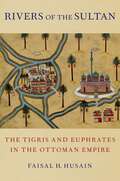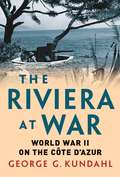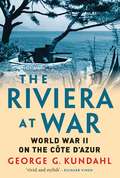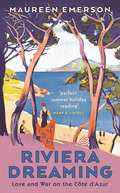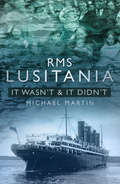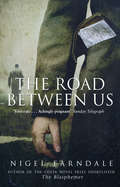- Table View
- List View
Risk of Exposure (Alpha Ops #6)
by Emmy CurtisHe is a trained professional-but nothing can prepare him for the hottest mission of his life. Assigned to protect his boss's daughter, British former SAS operative Malone Garrett breaks the first rule of covert surveillance-don't make contact. And especially don't take your mark out to dinner, then agree to a rooftop quickie. But now that Mal has Abby in his arms, he has no intention of ever letting her go. Abby Baston told herself it was a hit and quit, a one-nighter with a hot, handsome stranger whose hands were trained to take action. Working undercover for the CIA, she can't risk anything more. But when an international crisis ignites, Abby must make a call: trust Mal with her secret-and her heart-and partner up, or lose everything in a split second . . . Alpha Ops Series: Book 1: Dangerous Territory (novella)Book 2: Over the LineBook 3: Pushing the Limit Book 4: BlowbackBook 5: CompromisedBook 6: Risk of Exposure
The Ritchie Boys: The Untold Story Of The Jews Who Escaped The Nazis And Returned With The U. S. Army To Fight Hitler
by Bruce Henderson‘The last great, untold story of WWII… highly compelling’ Daily Mail
Rites of Retaliation: Civilization, Soldiers, and Campaigns in the American Civil War (The Steven and Janice Brose Lectures in the Civil War Era)
by Lorien FooteDuring the Civil War, Union and Confederate politicians, military commanders, everyday soldiers, and civilians claimed their approach to the conflict was civilized, in keeping with centuries of military tradition meant to restrain violence and preserve national honor. One hallmark of civilized warfare was a highly ritualized approach to retaliation. This ritual provided a forum to accuse the enemy of excessive behavior, to negotiate redress according to the laws of war, and to appeal to the judgment of other civilized nations. As the war progressed, Northerners and Southerners feared they were losing their essential identity as civilized, and the attention to retaliation grew more intense. When Black soldiers joined the Union army in campaigns in South Carolina, Georgia, and Florida, raiding plantations and liberating enslaved people, Confederates argued the war had become a servile insurrection. And when Confederates massacred Black troops after battle, killed white Union foragers after capture, and used prisoners of war as human shields, Federals thought their enemy raised the black flag and embraced savagery.Blending military and cultural history, Lorien Foote's rich and insightful book sheds light on how Americans fought over what it meant to be civilized and who should be extended the protections of a civilized world.
Rites of Retaliation: Civilization, Soldiers, and Campaigns in the American Civil War (The Steven and Janice Brose Lectures in the Civil War Era)
by Lorien FooteDuring the Civil War, Union and Confederate politicians, military commanders, everyday soldiers, and civilians claimed their approach to the conflict was civilized, in keeping with centuries of military tradition meant to restrain violence and preserve national honor. One hallmark of civilized warfare was a highly ritualized approach to retaliation. This ritual provided a forum to accuse the enemy of excessive behavior, to negotiate redress according to the laws of war, and to appeal to the judgment of other civilized nations. As the war progressed, Northerners and Southerners feared they were losing their essential identity as civilized, and the attention to retaliation grew more intense. When Black soldiers joined the Union army in campaigns in South Carolina, Georgia, and Florida, raiding plantations and liberating enslaved people, Confederates argued the war had become a servile insurrection. And when Confederates massacred Black troops after battle, killed white Union foragers after capture, and used prisoners of war as human shields, Federals thought their enemy raised the black flag and embraced savagery.Blending military and cultural history, Lorien Foote's rich and insightful book sheds light on how Americans fought over what it meant to be civilized and who should be extended the protections of a civilized world.
Rivals: An Addictive And Heartstopping Crime Saga Series (Georgina Garrett Series #2)
by Sam MichaelsThe streets of Battersea are about to get a new leader, one who will rule with an iron fist. It's the 1930s and Georgina Garrett has risen up from her tough beginnings to become the new boss of the Battersea gang. But not everyone is pleased with a female taking charge... With rival gangs trying to steal her turf, untrustworthy men in her midst and her dad lost deep in the bottle, Georgina has a lot to tackle. With her friends and family in constant danger and those closest to her questioning her leadership Georgina must use her wits to show that she's made for this job. The Garrett name is one to be feared and Georgina will begin to change the face of Battersea forever... Perfect for fans of Peaky Blinders, Martina Cole and Lesley Pearse.
Rivals in the Storm: How Lloyd George seized power, won the war and lost his government
by Damian CollinsA vivid biography in cinematic snapshots of David Lloyd George, one of the world's greatest statesmen.Brought up in rural North Wales, David Lloyd George attended neither a grand school nor ancient university. He was very much an outsider. And yet he rose through the ranks with charisma, fierce intelligence and fighting spirit to become, as Churchill put it in his tribute, a man who 'stood, when at his zenith, without a rival'.But his rise was not without its hardships, and in Rivals in the Storm, experienced MP and author Damian Collins focuses on the impact of Lloyd George's personality on other leading politicians, in driving progressive reforms through government, changing the course of the First World War to lead the Allies to victory, and cementing Britain's alliance with America.Covering Lloyd George's emergence as the dominating political personality in Great Britain to the aftermath of his resignation, this fascinating biography takes you inside the rooms where the important decisions happened, and shows the bitter struggles as well as the triumphs of this great man of his or any other age, who nonetheless fell short of his own high expectations.
Rivals in the Storm: How Lloyd George seized power, won the war and lost his government
by Damian CollinsA vivid biography in cinematic snapshots of David Lloyd George, one of the world's greatest statesmen.Brought up in rural North Wales, David Lloyd George attended neither a grand school nor ancient university. He was very much an outsider. And yet he rose through the ranks with charisma, fierce intelligence and fighting spirit to become, as Churchill put it in his tribute, a man who 'stood, when at his zenith, without a rival'.But his rise was not without its hardships, and in Rivals in the Storm, experienced MP and author Damian Collins focuses on the impact of Lloyd George's personality on other leading politicians, in driving progressive reforms through government, changing the course of the First World War to lead the Allies to victory, and cementing Britain's alliance with America.Covering Lloyd George's emergence as the dominating political personality in Great Britain to the aftermath of his resignation, this fascinating biography takes you inside the rooms where the important decisions happened, and shows the bitter struggles as well as the triumphs of this great man of his or any other age, who nonetheless fell short of his own high expectations.
The River Between Us
by Liz FenwickA forgotten house and a secret hidden for a century… 'Wonderfully evocative’ Judy Finnigan 'An absolute delight!' Hazel Gaynor ‘Wonderful escapism’ Tracy Rees ’A lovely story' Erica James ‘Gloriously rich’ Rachel Hore ‘Sublime storytelling’ Cathy Bramley ‘Emotional’ Kate Ryder
A River in May
by Edward WilsonA magnificent debut novel, which follows in the spirit of Conrad's Heart of Darkness, in which an alienated student named Lopez joins the Vietnam war to escape from his past and himself. Forced out of self-pity by the brutality and injustice surrounding him, Lopez begins to shed his layers of acquired culture, identifying instead with the Vietnamese and their cause. 'Stylistically sophisticated, visually and emotionally present; the pace is good and the author knows how to hold the reader's attention.'
River of Death (Sound Ser.)
by Alistair MacLeanThe classic tale of adventure and the dark secrets of a lost city in the Brazilian jungle, from the acclaimed master of action and suspense.
River of Death--The Chickamauga Campaign: Volume 1: The Fall of Chattanooga (Civil War America)
by William Glenn RobertsonThe Battle of Chickamauga was the third bloodiest of the American Civil War and the only major Confederate victory in the conflict's western theater. It pitted Braxton Bragg's Army of Tennessee against William S. Rosecrans's Army of the Cumberland and resulted in more than 34,500 casualties. In this first volume of an authoritative two-volume history of the Chickamauga Campaign, William Glenn Robertson provides a richly detailed narrative of military operations in southeastern and eastern Tennessee as two armies prepared to meet along the "River of Death." Robertson tracks the two opposing armies from July 1863 through Bragg's strategic decision to abandon Chattanooga on September 9. Drawing on all relevant primary and secondary sources, Robertson devotes special attention to the personalities and thinking of the opposing generals and their staffs. He also sheds new light on the role of railroads on operations in these landlocked battlegrounds, as well as the intelligence gathered and used by both sides.Delving deep into the strategic machinations, maneuvers, and smaller clashes that led to the bloody events of September 19@–20, 1863, Robertson reveals that the road to Chickamauga was as consequential as the unfolding of the battle itself.
River of Fire: The Clydebank Blitz
by John MacLeod"MacLeod is a splendid and elegiac narrator of neglected patches of Scotland's history and brings his poetic gifts again to this, the single most dreadful event in our nation's story" - The Observer "An unflinching record of what remains of Scotland's greatest human disaster in modern history" - The Herald Vibrating with endeavours for Britain's effort against the might of Nazi Germany, Clydebank was - in hindsight - an obvious target for the attentions of the Luftwaffe. When, on the evening of 13 March 1941, the authorities first detected that Clydebank was 'on beam' - targeted by the primitive radio-guidance system of the German bombers - no effort was made to raise the alarm or to direct the residents to shelter or flight. Within the hour, a vast timber-yard, three oil-stores, and two distilleries were ablaze, one pouring flaming whisky into a burn that ran blazing into the Clyde itself in vivid ribbons of fire. And still the Germans came; and Clydebank, now an inferno, lay illuminated and defenceless as heavy bombs of high-explosive, as land-mines and parachute blasters began to fall ...With reference to written sources and the memories of those who survived the experience, John MacLeod tells the story of the Clydebank Blitz and the terrible scale of death and devastation, speculating on why its incineration has been so widely forgotten and its ordeal denied any place in national honour.
River of Stars
by Guy Gavriel KayIn his critically acclaimed novel Under Heaven, Guy Gavriel Kay told a vivid and powerful story inspired by China’s Tang Dynasty. Now, the international bestselling and multiple award-winning author revisits that invented setting four centuries later – a world inspired this time by the glittering, decadent Song Dynasty.
River Plate 1939: The sinking of the Graf Spee (Campaign)
by Tony Bryan Angus KonstamDays before the outbreak of World War II a handful of German commerce raiders put out to sea to prey on Allied merchantmen. Amongst them was the Panzerschiff ('armoured ship') Graf Spee, a formidable warship that boasted the firepower of a battleship but the size, speed and range of a cruiser. When World War II commenced, under the command of Captain Langsdorff the Graf Spee began a hunting spree across the South Atlantic and the Indian Ocean that eventual took her to the River Plate in search of her next victim – an Allied convoy. Instead she found three Royal Navy cruisers under the command of Commodore Harwood, eager to put an end to the 'pocket battleship' that had been terrorizing Allied merchant ships.Featuring full colour artwork, archive photographs and meticulous research, this comprehensive volume explores the thrilling story behind the Battle of the River Plate, an engagement that unquestionably demonstrated the effectiveness of British seapower and diplomacy on an international stage.
River Plate 1939: The sinking of the Graf Spee (Campaign #171)
by Tony Bryan Angus KonstamDays before the outbreak of World War II a handful of German commerce raiders put out to sea to prey on Allied merchantmen. Amongst them was the Panzerschiff ('armoured ship') Graf Spee, a formidable warship that boasted the firepower of a battleship but the size, speed and range of a cruiser. When World War II commenced, under the command of Captain Langsdorff the Graf Spee began a hunting spree across the South Atlantic and the Indian Ocean that eventual took her to the River Plate in search of her next victim – an Allied convoy. Instead she found three Royal Navy cruisers under the command of Commodore Harwood, eager to put an end to the 'pocket battleship' that had been terrorizing Allied merchant ships.Featuring full colour artwork, archive photographs and meticulous research, this comprehensive volume explores the thrilling story behind the Battle of the River Plate, an engagement that unquestionably demonstrated the effectiveness of British seapower and diplomacy on an international stage.
Rivers of the Sultan: The Tigris and Euphrates in the Ottoman Empire
by Faisal H. HusainThe Tigris and Euphrates rivers run through the heart of the Middle East and merge in the area of Mesopotamia known as the "cradle of civilization." In their long and volatile political history, the sixteenth century ushered in a rare era of stability and integration. A series of military campaigns between the Mediterranean Sea and the Persian Gulf brought the entirety of their flow under the institutional control of the Ottoman Empire, then at the peak of its power and wealth. Rivers of the Sultan tells the history of the Tigris and Euphrates during the early modern period. Under the leadership of Sultan Süleyman I, the rivers became Ottoman from mountain to ocean, managed by a political elite that pledged allegiance to a single household, professed a common religion, spoke a lingua franca, and received orders from a central administration based in Istanbul. Faisal Husain details how Ottoman unification institutionalized cooperation among the rivers' dominant users and improved the exploitation of their waters for navigation and food production. Istanbul harnessed the energy and resources of the rivers for its security and economic needs through a complex network of forts, canals, bridges, and shipyards. Above all, the imperial approach to river management rebalanced the natural resource disparity within the Tigris-Euphrates basin. Istanbul regularly organized shipments of grain, metal, and timber from upstream areas of surplus in Anatolia to downstream areas of need in Iraq. Through this policy of natural resource redistribution, the Ottoman Empire strengthened its presence in the eastern borderland region with the Safavid Empire and fended off challenges to its authority. Placing these world historic bodies of water at its center, Rivers of the Sultan reveals intimate bonds between state and society, metropole and periphery, and nature and culture in the early modern world.
Rivers of the Sultan: The Tigris and Euphrates in the Ottoman Empire
by Faisal H. HusainThe Tigris and Euphrates rivers run through the heart of the Middle East and merge in the area of Mesopotamia known as the "cradle of civilization." In their long and volatile political history, the sixteenth century ushered in a rare era of stability and integration. A series of military campaigns between the Mediterranean Sea and the Persian Gulf brought the entirety of their flow under the institutional control of the Ottoman Empire, then at the peak of its power and wealth. Rivers of the Sultan tells the history of the Tigris and Euphrates during the early modern period. Under the leadership of Sultan Süleyman I, the rivers became Ottoman from mountain to ocean, managed by a political elite that pledged allegiance to a single household, professed a common religion, spoke a lingua franca, and received orders from a central administration based in Istanbul. Faisal Husain details how Ottoman unification institutionalized cooperation among the rivers' dominant users and improved the exploitation of their waters for navigation and food production. Istanbul harnessed the energy and resources of the rivers for its security and economic needs through a complex network of forts, canals, bridges, and shipyards. Above all, the imperial approach to river management rebalanced the natural resource disparity within the Tigris-Euphrates basin. Istanbul regularly organized shipments of grain, metal, and timber from upstream areas of surplus in Anatolia to downstream areas of need in Iraq. Through this policy of natural resource redistribution, the Ottoman Empire strengthened its presence in the eastern borderland region with the Safavid Empire and fended off challenges to its authority. Placing these world historic bodies of water at its center, Rivers of the Sultan reveals intimate bonds between state and society, metropole and periphery, and nature and culture in the early modern world.
Riveted (Saints of Denver #3)
by Jay CrownoverThe next book in the smoking hot SAINTS OF DENVER series from NYT bestselling author of the MARKED MEN series, Jay Crownover
Riviera at War: World War II on the Côte d'Azur
by George G. KundahlDuring World War II three distinct forces opposed the Allies - Germany, Italy, and Japan. Few areas of the world experienced domination by more than a single one of these, but southeastern France – the region popularly known as the Riviera or Cote d'Azur - was one. Not only did inhabitants suffer through Italian Fascism and German Nazism but also under a third hardship at times even more oppressive - the rule of Vichy France. Following a nine-month prelude, the reality of World War II burst onto the Riviera in June 1940 when the region had to defend itself against the Italian army and ended in April 1945 with a battle against German and Italian forces in April 1945, a period longer than any other part of France. In this book, George G. Kundahl tells for the first time the full story of World War II on the French Riviera. Featuring previously unseen sources and photographs, this will be essential reading for anyone interested in wartime France.
Riviera at War: World War II on the Côte d'Azur
by George G. KundahlDuring World War II three distinct forces opposed the Allies - Germany, Italy, and Japan. Few areas of the world experienced domination by more than a single one of these, but southeastern France - the region popularly known as the Riviera or Cote d'Azur - was one. Not only did inhabitants suffer through Italian Fascism and German Nazism but also under a third hardship at times even more oppressive - the rule of Vichy France. Following a nine-month prelude, the reality of World War II burst onto the Riviera in June 1940 when the region had to defend itself against the Italian army and ended in April 1945 with a battle against German and Italian forces in April 1945, a period longer than any other part of France. In this book, George G. Kundahl tells for the first time the full story of World War II on the French Riviera. Featuring previously unseen sources and photographs, this will be essential reading for anyone interested in wartime France.
Riviera Dreaming: Love and War on the Côte d'Azur (20120730 Ser. #20120730)
by Maureen EmersonIn 1926 Barry Dierks, a young American architect, arrived in Paris and fell in love with France... With his partner, an ex-officer in the British Army, he built a white, flat-roofed Modernist masterpiece that rested on the rocks below the Esterel, with views across the Mediterranean. They called it Le Trident. From the moment it was built, it captivated the Riviera. As commissions for more villas flooded in, Barry Dierks and Eric Sawyer, "those two charmers", flourished at the heart of Riviera society. Over the years, Dierks would design and build over 70 of the Riviera's most recognisable villas for clients ranging from Somerset Maugham's Villa Mauresque and Jack Warner's Villa Aujourd'hui to the Marquess of Cholmondeley's Villa Le Roc, and Maxine Elliott's Chateau de l'Horizon, later the home of Aly Khan and Rita Hayworth. Riviera Dreaming tells the dazzling story of the lives, loves and adventures that played out behind the walls of these glamorous houses and provides an unparalleled portrait of life on the Cote d'Azur at the height of the Jazz Age.
The Riviera House: a breathtaking and escapist love story set on the French Riviera - the perfect summer read
by Natasha LesterThe brand-new escapist summer romance from the internationally bestselling author of The Paris Secret!ONE UNFORGETTABLE SUMMER WILL UNLOCK A DECADES-OLD SECRET . . . When Remy discovers she's mysteriously inherited a house on the French Riviera, she drops everything to go there, desperately seeking answers and an escape from her broken heart. There, she's shocked to find a catalogue of the artwork known to have been stolen during WWII and is even more surprised when she recognises one as the painting that hung in her childhood bedroom. In Paris, 1939, while working at the Louvre, bold and beautiful Eliane falls for talented painter Xavier. But when the Nazis occupy the city, Xavier leaves for England, leaving Eliane behind. Heartbroken, she throws herself into helping the resistance catalogue the priceless treasures the Nazis are stealing. But Eliane is playing a dangerous game, and after a trip to a stunning home on the French Riviera, she realises she may have put her trust in the wrong person . . . As Remy questions everything she thought she knew about her family, Eliane finds herself in real peril. Could it be that the Riviera house holds more secrets than either Remy or Eliane are ready to face? Set between war-torn Paris and the present day, The Riviera House is a breathtakingly beautiful story of love and sacrifice. Perfect for fans of Rachel Hore, Lucinda Riley and Tracy ReesPRAISE FOR NATASHA LESTER:'A meticulously researched novel about the lengths people will go to protect one another, and a love that lasts a lifetime . . . an extraordinary book' MARIE CLAIRE'Divine' GILL PAUL, bestselling author of The Secret Wife'An emotional and sweeping tale' CHANEL CLEETON, bestselling author of Next Year in Havana 'A splendid, breathtaking novel, full of mystery and passion...a must read!' JEANNE MACKIN, author of The Last Collection
RMS Lusitania: It Wasn't And It Didn't
by Michael MartinWithin hours of the sinking of RMS Lusitania by a German submarine off the Cork coast in May 1915, a narrative was created which over time became the accepted truth of the incident. Many people today still believe the sinking of the Lusitania was a savage attack on an innocent vessel that brought America into the war. In this book, author and historian Michael Martin raises a series of disturbing questions that challenge this longheld perspective. Examining a raft of old and new evidence suggesting a more sinister function of RMS Lusitania, this book explores the widespread use of civilian vessels within the war effort; it shines a light on the operational response of the Royal Navy in the immediate aftermath of the incident; and it looks at the nature of the response of the United States at this crucial juncture. And, above all, this book questions the narrative that has grown up around one of the most pivotal junctures in the war to end all wars.
The Road Between Us
by Nigel Farndale1939: In a hotel room overlooking Piccadilly Circus, two young men are arrested. Charles is court-martialled for ‘conduct unbecoming’; Anselm is deported home to Germany for ‘re-education’ in a brutal labour camp. Separated by the outbreak of war, and a social order that rejects their love, they must each make a difficult choice, and then live with the consequences. 2012: Edward, a diplomat held hostage for eleven years in an Afghan cave, returns to London to find his wife is dead, and in her place is an unnerving double – his daughter, now grown up. Numb with grief, he attempts to re-build his life and answer the questions that are troubling him. Was his wife’s death an accident? Who paid his ransom? And how was his release linked to Charles, his father? As dark and nuanced as it is powerful and moving, The Road Between Us is a novel about survival, redemption and forbidden love. Its moral complexities will haunt the reader for days after the final page has been turned.

